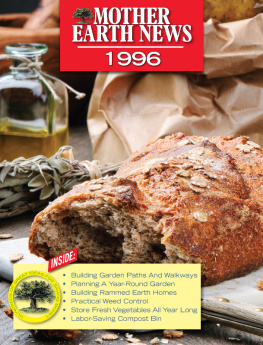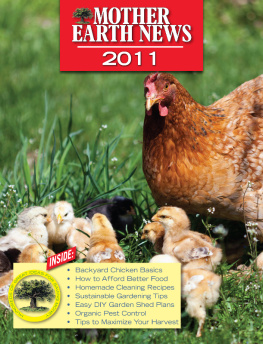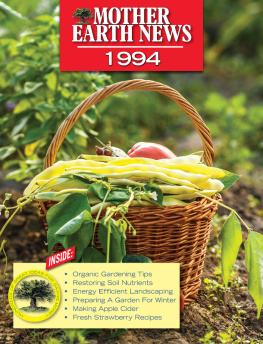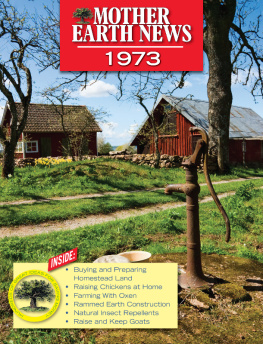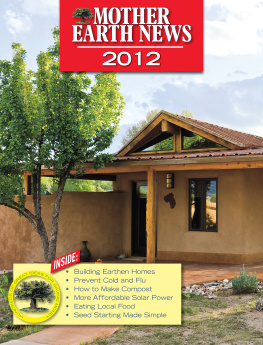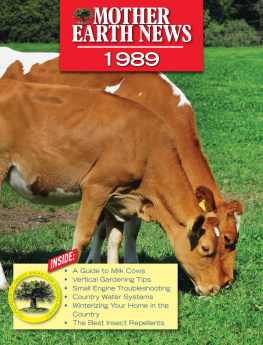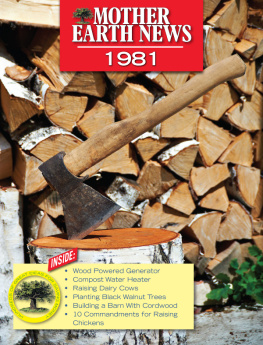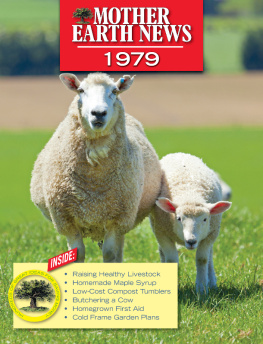Mother Earth News - Mother Earth News 1996
Here you can read online Mother Earth News - Mother Earth News 1996 full text of the book (entire story) in english for free. Download pdf and epub, get meaning, cover and reviews about this ebook. year: 1996, publisher: Mother Earth News, genre: Science / Home and family. Description of the work, (preface) as well as reviews are available. Best literature library LitArk.com created for fans of good reading and offers a wide selection of genres:
Romance novel
Science fiction
Adventure
Detective
Science
History
Home and family
Prose
Art
Politics
Computer
Non-fiction
Religion
Business
Children
Humor
Choose a favorite category and find really read worthwhile books. Enjoy immersion in the world of imagination, feel the emotions of the characters or learn something new for yourself, make an fascinating discovery.
- Book:Mother Earth News 1996
- Author:
- Publisher:Mother Earth News
- Genre:
- Year:1996
- Rating:5 / 5
- Favourites:Add to favourites
- Your mark:
- 100
- 1
- 2
- 3
- 4
- 5
Mother Earth News 1996: summary, description and annotation
We offer to read an annotation, description, summary or preface (depends on what the author of the book "Mother Earth News 1996" wrote himself). If you haven't found the necessary information about the book — write in the comments, we will try to find it.
Mother Earth News 1996 — read online for free the complete book (whole text) full work
Below is the text of the book, divided by pages. System saving the place of the last page read, allows you to conveniently read the book "Mother Earth News 1996" online for free, without having to search again every time where you left off. Put a bookmark, and you can go to the page where you finished reading at any time.
Font size:
Interval:
Bookmark:

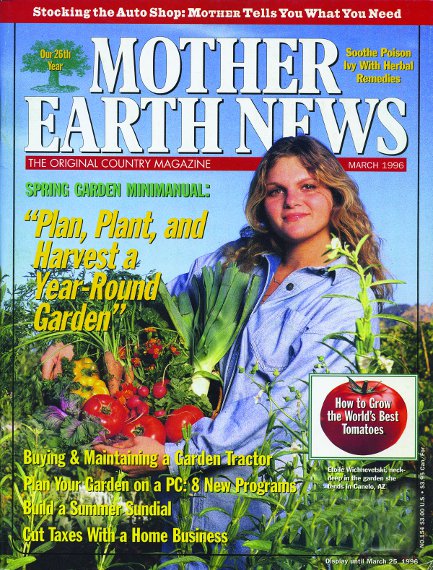
MOTHER EARTH NEWS readers share their farming advice, fun tips and country folklore, including shortcuts to spring chores, a flowerbed protector and cooking trout in the dishwasher.
Shortcuts to Spring Chores
It was with a great deal of interest that I read the piece submitted by Ms. Carol S. Larson of Harvard, IL dealing with the utilization of discarded carpet as a permanent mulch in the garden ["Country Lore, MOTHER EARTH NEWS NO. 152]. During the early and mid 1960s, I assisted my grandmother in her garden, where carpet was utilized for just the purpose Ms. Larson speaks of.
As a resident of the Blue Ridge foothills here in Northwest Georgia, I would add one enjoinder to Ms. Larsons suggestion. Any one who would utilize carpet remnants for mulch in an area inhabited by venomous members of the crotalid family would do well to forego any carpet of a pattern or coloration resembling that of the indigenous reptiles. My Cisco, Georgia, garden is located next to a hollow that harbors a spring and a creek. The extremely dry summer we recently experienced witnessed many a copperhead and an occasional rattlesnake utilizing the garden for provender. I have been more successful in avoiding contact with these fellows since using the polypropylene type synthetic backing-a material that allows passage of water and fairly good weed suppression. This material has also allowed me to rapidly identify those members of the crotalid family touring my garden and humanely remove them back to the hollow from whence they came (As a silver medalist in the Southeast Asia War Games of 1960 through 1975, I am reluctant to dispatch any creature for merely being itself.).
Thank you for an extremely informative publication.
-Joseph R. Dombroski
Chatsworth, GA
Setting a Lean-proof Post
The usual technique for planting fence posts is fairly standard, whether for 4 by 4s or 6 by 6s or round posts. Dig a hole and throw a little gravel or concrete in the bottom. Then insert the post, plumbing it while adding more gravel or concrete to the hole. Easy enough.
Sometimes, however, a post needs to be especially rigid and well-anchored, able to resist a lot of lateral stress. These might include lone gate posts, corners and some sign posts having horizontal, load-bearing arms. Heres a sure-fire method of installation that adds a new wrinkle to the usual procedure, and will prevent a post from eventually loosening or leaning.
To begin, drive a stake at least 6 inches deep at the center of the post hole location. Then, digging all around the stake, excavate a circular form hole, 24-28 inches in diameter and approximately 5 inches deep. At the center of this shallow, dish shape hole (the spot still marked by the stake), dig the post hole in the usual manner. Obviously, the deeper the hole, the more rigid the post, so dig as deep as practicality will allow.
Pour a couple of inches of concrete into the hole first, to act as a support pad for the post. Then set the post, positioning and plumbing it as you add enough concrete to steady it in the hole. Be sure to tamp the concrete mix as you pour, in order to prevent voids or weak spots. Continue pouring the concrete mix until it fills the narrow post hole and spreads out into the shallow form hole to a depth roughly 1 or 2 inches below ground level.
The mix in the form hole should look like a big donut around the base of the post. For added strength, you may wish to float a few short pieces of steel reinforcing rod (rebar) down into the mix. More importantly, trowel a small amount of slope, or fall, into the surface of the donut, so that it will shed water away from the post. After curing, the concrete may be covered with sod/pebbles, etc., for a cleaner appearance.
This donut pad, gripping in the soil at 90 degree angles to the post, will hold the ground much more effectively than the usual sleeve of concrete, and the post will be extraordinarily rigid. I used this technique to anchor a single 6x6 post on which I mounted a 16-foot tubular metal gate, and no loosening or leaning has occurred in years. Try it.
-Mike Mitchell
Danville, VA
Flower Bed Protector
A way to protect any flower patch from garden hose or electric cord is to use parts of discarded lawn chair tubing. Cut with a hacksaw or a pipe cutter about 6 inches from the 90 degree bend and 12 inches the other way. Push the longest end into the ground at the edge of the flower patch to about 4 inches above the surface where you want to protect your flowers. When not in use, it can be left there for next time, but turned into the flowers so it is out of the way of the lawn mower or feet.
-D. E. Andrews
Riding Mountain, Manitoba
Maggies Dishwasher Trout
My sister Maggie has never been one to do things the usual way. I admit 1 was skeptical when she told me about her unique method for cooking trout, but I had to try it. It worked so well I told all my neighbors. Now my neighbor Marydel Portner wont have her trout any other way.
The first thing you do is catch some trout. Then clean them and prepare them to be eaten. Put a little butter and lemon on them, wrap them in foil and place them on the top rack of your dishwasher. Turn it on for a full cycle. (No soap in there though.) The heat from the water cooks them perfectly. Theyll emerge from the dishwasher tender and ready to be served.
-Charles Miller
Wellington, CO
Golden Eggs
To check and see
if an egg is old,
Place in water
Thats very cold.
If on its side
It comes to rest,
Then you can bet
Its very fresh.
When three or four days
Have gone bye
Youll see a tilt,
A rake, a rise.
An upright egg
is ten days old,
For baking it
Is solid gold.
A floating egg
Handle With Care!
You dont want it
Exposed to air!
-Knight C. Duerig
King Hill, ID
Well Bet You Never Thought Glue Can
Remove a splinter. Coat the splinter with a drop of glue, wait for it to dry, then peel off the dried glue. The splinter should be stuck to it.
Seal plants. Gardeners can use glue to seal the ends of pruned stems and branches against insects and excessive moisture loss.
Prevent broken shoelaces from fraying. Dip the ends.
Fix small hole in walls. Small nail holes can be filled by squirting in a drop before painting.
Make moldable dough that dries without baking. Mix equal parts glue, flour and cornstarch. Mix and knead well until blended. If too dry, add more glue. If too moist, add more flour and cornstarch. Food coloring may be added if desired. Dough can be molded into any desired shape to create animals, figurines, ornaments, and jewelry. Dough keeps for weeks in a zipped storage bag.
Tighten a screw hole.
Font size:
Interval:
Bookmark:
Similar books «Mother Earth News 1996»
Look at similar books to Mother Earth News 1996. We have selected literature similar in name and meaning in the hope of providing readers with more options to find new, interesting, not yet read works.
Discussion, reviews of the book Mother Earth News 1996 and just readers' own opinions. Leave your comments, write what you think about the work, its meaning or the main characters. Specify what exactly you liked and what you didn't like, and why you think so.

